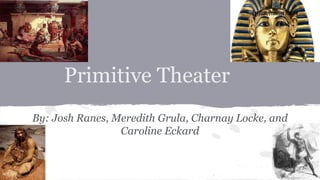
Primitive Theatre
- 1. Primitive Theater By: Josh Ranes, Meredith Grula, Charnay Locke, and Caroline Eckard
- 2. What is Primitive Theater? Era: Stone Age (6000 BCE - 2000 BCE) We know of primitive theater thanks to anthropologists, who have studied artifacts and cave drawings depicting men who re-enact hunts that they would go on with animal skins depicting the animals and their usual attire to depict the humans.
- 3. How would they perform? The homosapiens would imitate the hunt of the animal when asked how it went. Imitation was their form of theatre. It is the very foundation of all theatre. Other forms of theatre the cavemen would participate in included dance. They would dance for the Gods, one person would be the focus, a tribute to or embodiment of the God(s), or a sacrifice. The figure is usually in a mask, made from any organic materials that could be mustered up.
- 4. Costumes In the Primitive ages of theater they used animal skin as their costumes. They used the animal skin to reenact the hunt scene, with the men wearing the skin as the animals and the men wearing less animal skin as the hunters.
- 5. Eventually primitive tribes began to act out the hunt before they started hunting. They did this so often that it became a ritual. A ritual is something performed repeatedly in exactly the same way, and they believed that if they did this it would create magic that would bring them success. These rituals became so popular and common that they elected one person from the tribe to oversee the rituals. This man was called a Shaman. Rituals
- 6. Religion and Theater During this time in history, religion and theater were the same thing. Theatrical performances were an important part of religious ceremonies.
- 7. Ancient Egyptian Theatre Ancient Egypt started in 3500 BC and ended around 350 BC, when Queen Cleopatra killed herself. In the sense of Ancient Egyptian theatre there are only four different types of plays that existed.
- 8. Osiris Passion Play Set, the God of evil, becomes jealous of his brother Osiris, and tricks him into a coffin nailing him inside, still alive. Isis, the wife of Osiris, finds his coffin and buries him correctly only to have Set dig Osiris up and dismember him, later scattering the body parts all over Earth. Isis and her son, Apuat, find all the pieces and buries them once again. Osiris is then resurrected and becomes the King of the Dead, ruling over the mortals that ascend to heaven.
- 9. The Medical Plays All evolved around the idea of magical healing, usually with a simple plot. In one, Isis, whose child is bitten by a scorpion, heals her son using artificial respiration and a magic cure.
- 10. The Heb Sed Play The Heb Sed Play, also called the Coronation Jubilee, is a celebration of the Pharaoh’s thirty years on the throne, the people enact all things that have happened over those thirty years and the events of his region.
- 11. The Ra Play Ra is the sun god, his play follows his struggle with Apophis, the snake god of the underworld.
- 12. The Passion Play The most famous of all passion plays was the Osiris Passion play, but that wasn’t the only one. In fact for 2000 years they had one passion play annually, each performance lasted several days and included battle scenes with actual killings.